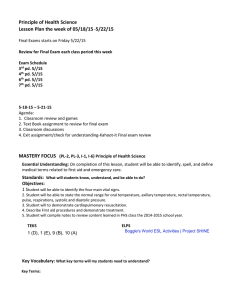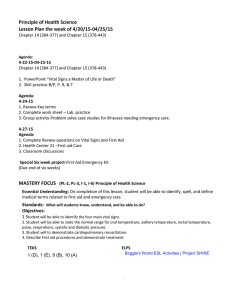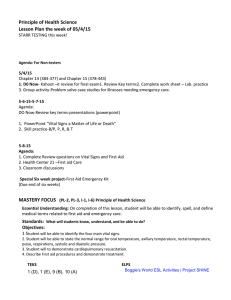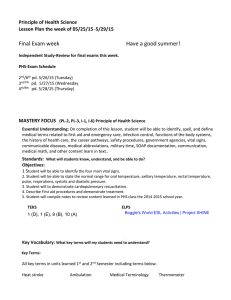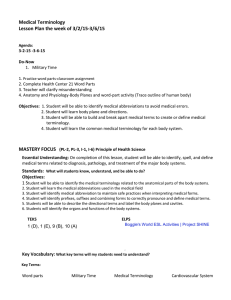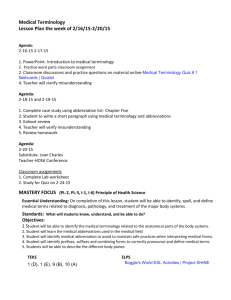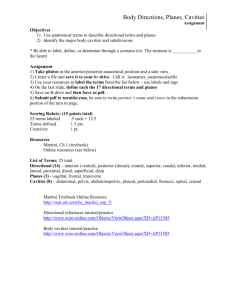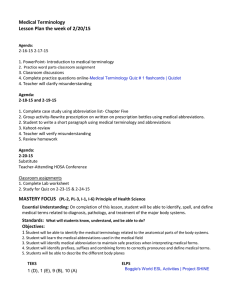Principle of Health Science Lesson Plan 3-23-15-3-27-13
advertisement
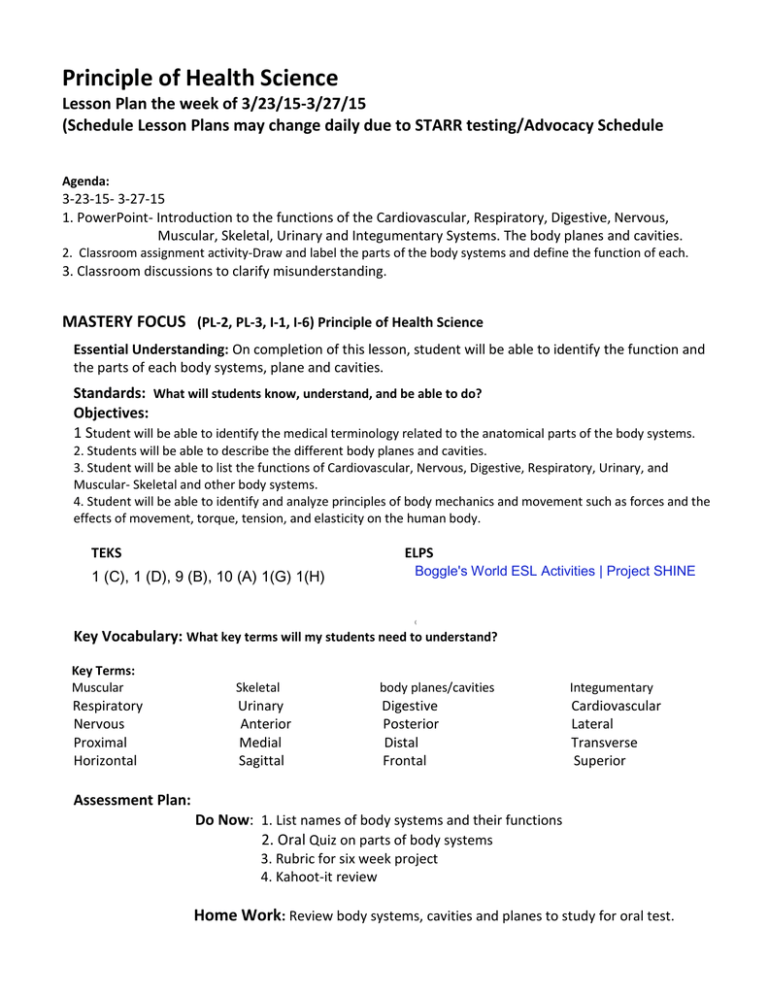
Principle of Health Science Lesson Plan the week of 3/23/15-3/27/15 (Schedule Lesson Plans may change daily due to STARR testing/Advocacy Schedule Agenda: 3-23-15- 3-27-15 1. PowerPoint- Introduction to the functions of the Cardiovascular, Respiratory, Digestive, Nervous, Muscular, Skeletal, Urinary and Integumentary Systems. The body planes and cavities. 2. Classroom assignment activity-Draw and label the parts of the body systems and define the function of each. 3. Classroom discussions to clarify misunderstanding. MASTERY FOCUS (PL-2, PL-3, I-1, I-6) Principle of Health Science Essential Understanding: On completion of this lesson, student will be able to identify the function and the parts of each body systems, plane and cavities. Standards: What will students know, understand, and be able to do? Objectives: 1 Student will be able to identify the medical terminology related to the anatomical parts of the body systems. 2. Students will be able to describe the different body planes and cavities. 3. Student will be able to list the functions of Cardiovascular, Nervous, Digestive, Respiratory, Urinary, and Muscular- Skeletal and other body systems. 4. Student will be able to identify and analyze principles of body mechanics and movement such as forces and the effects of movement, torque, tension, and elasticity on the human body. TEKS ELPS 1 (C), 1 (D), 9 (B), 10 (A) 1(G) 1(H) Boggle's World ESL Activities | Project SHINE ( Key Vocabulary: What key terms will my students need to understand? Key Terms: Muscular Skeletal body planes/cavities Integumentary Respiratory Nervous Proximal Horizontal Urinary Anterior Medial Sagittal Digestive Posterior Distal Frontal Cardiovascular Lateral Transverse Superior Assessment Plan: Do Now: 1. List names of body systems and their functions 2. Oral Quiz on parts of body systems 3. Rubric for six week project 4. Kahoot-it review Home Work: Review body systems, cavities and planes to study for oral test. LESSON CYCLE I. Students Will learn the key terms, time, medical abbreviation, and word parts related to the body system. Why It Is Important? (The students need to know the meaning of the key terms, medical abbreviations, and the basic structure of the human body related to the body systems to treat and recognize biological, physiological and chemical imbalances of the human body. Health care workers are expected to know the function of each body systems and its part as well as recognizing the sites for the body cavities and planes on their clients/patients. Health Science students must learn the basic fundamentals of the body reacts to medications, medical illnesses, infections of what is needed to prevent medical errors and provide the highest optimal care to patients by correctly Interpreting the anatomical sites on the patient’s body. II. Introduction to New Material – a. Students will view and discuss a PowerPoint on Introduction to Anatomy and Physiology. b. Review content in text book and handouts. c. Review content related to lesson per website and other links. d. Supply students with visual displays and classroom manipulatives of the body organs. III. Guided Practice a. Teacher will clarify and check for understanding by asking open-ended questions. b. Teacher will pace the classroom to clarify misunderstanding. c. Teacher will introduce content to be learned and review key terms. d. Teacher will demonstrate skill practices and the body organs on visual mannequin. e. Teacher will review agenda and objectives daily f. Teacher will review resources and equipment needed to problem solve student centered lessons. g. Teacher will provide an outline and rubric for 6 weeks project. IV. Independent Practice a. Student to define and write key terms. b. Student to take notes from PowerPoint. c. Student to complete homework d. Student to complete worksheets in class e. Student to identify and draw the parts of the body systems using the proper medical terms f. Groups and independent study to learn medical terms. g. Student to independently research the body systems in text & internet surfing. V. The Closing – Classroom discussions to check for understanding. Ask students did we meet and learn the objectives for the day. Play kahoot or other games to check for mastery. Clarify misunderstanding. How will I engage my students in learning? How will I lead my students to mastery? CHECKS FOR UNDERSTANDING (I-2) 1 Engage and Connect (30-min): Do Now: 15 minutes Hands on group activity Independent practice Online group studies. Group activity –Problem solve questions related to the body systems. 2 Introduce New Learning (15-20 min): PowerPoint- Introduction to Anatomy and Physiology Functions of the body systems Health Century 21 Movie “Miracle Hands” Demonstrate skill practice Explain why correct pronunciation of medical terms prevent medical errors. Introduce Prefixes, suffixes, and combining forms to make word parts. Provide an outline and supplies for student to complete six-week project.. 3 Lead Guided and Independent Practice (25 min): Guided Practice (10 min): Demonstrate How to use combing forms and word parts of each body systems. Student supplied with text and other research materials. Review actual malpractice cases due to misinterpreting MD orders or medical documentation. Health Century 21-lesson plans, online practice and work sheets. Review Do Now Clarify misunderstanding Allow students to demonstrate what was learned Student provide feedback by demonstrating skills. Student are able to voice why lesson is important during guided questions Student provide feedback on the overhead board practicing breaking down medical terms Clarify misunderstanding. By asking questions and reteach material as needed. Problem solve case studies to define medical terms and abbreviations. Complete lab worksheet Complete homework Independent Practice (25-30 min): 4 Close the Lesson and Assess Mastery (10 min): Check understanding by open ended questions involving all students. Play Kohoot. Exit ticket Quizzes Peer Review Feedback Accountable talk. Test (six week) DIFFERENTIATION (I-3) How will I scaffold and/or accelerate learning? For whom? How will I group my students? SCAFFOLD: A Series of online studies and quizzes ACCELERATE: Have students read medical terms out loud and use prior knowledge learn to problem solve. Group activity- Student will present to peers six weeks project during gallery walk. Draw and trace a peers’ body to identify the parts of the body & the body planes using medical terminology. GROUP: Group according to academic level (high performing students grouped with lower performing students. (4-5 students per group). ESL student grouped with a Spanish speaking student. LOGISTICS (I-6, I-10) What materials, resources, and technology will I need to prepare and arrange? Text Book Health Century 21 Student workbook-Medical Terminology by Ann Ehrlich & Carol Schroeder Instructor’s Manual Introduction to Medical Terminology by Ann Ehrlich & Carol Schroeder Tracing paper and markers scissors index cards Lab-top (technology based lesson) Diversified Health Occupational PowerPoint Case studies Bulletin board Paper for tracing
